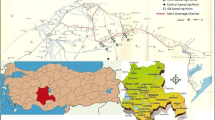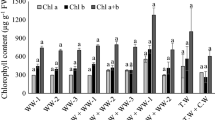Abstract
Untreated wastewater is routinely used for agricultural activities in water-stressed regions, thereby causing severe ecological risks by various pollutants. Hence, management strategies are needed to cope with the environmental issues related to wastewater use in agriculture. This pot study evaluates the effect of mixing either freshwater (FW) or groundwater (GW) with sewage water (SW) on the buildup of potentially toxic elements (PTEs) in soil and maize crop. Results revealed that SW of Vehari contains high levels of Cd (0.08 mg L−1) and Cr (2.3 mg L−1). Mixing of FW and GW with SW increased soil contents of As (22%) and decreased Cd (1%), Cu (1%), Fe (3%), Mn (9%), Ni (9%), Pb (10%), and Zn (4%) than SW “alone” treatment. Risk indices showed high-degree of soil-contamination and very-high ecological risks. Maize accumulated considerable concentrations of PTEs in roots and shoot with bioconcentration factor > 1 for Cd, Cu, and Pb and transfer factor > 1 for As, Fe, Mn, and Ni. Overall, mixed treatments increased plant contents of As (118%), Cu (7%), Mn (8%), Ni (55%), and Zn (1%), while decreased those of Cd (7%), Fe (5%), and Pb (1%) compared to SW “alone” treatments. Risk indices predicted possible carcinogenic risks to cow (CR 0.003 > 0.0001) and sheep (CR 0.0121 > 0.0001) due to consumption of maize fodder containing PTEs. Hence, to minimize possible environmental/health hazards, mixing of FW and GW with SW can be an effective strategy. However, the recommendation greatly depends on the composition of mixing waters.


Similar content being viewed by others
Data availability
All data, materials, and software application support their published claims and comply with field standards.
References
Alothman, Z. A., & Shahid, M. (2022). Recent advances in removal of toxic elements from water using MOFs: A critical review. Arabian Journal of Chemistry, 15(12), 104319. https://doi.org/10.1016/j.arabjc.2022.104319
Anwar, H., Shahid, M., Niazi, N. K., Khalid, S., Tariq, T. Z., Ahmad, S., . . . & Abbas, G. (2021). Risk assessment of potentially toxic metal (loid) s in Vigna radiata L. under wastewater and freshwater irrigation. Chemosphere, 265, 129124. https://doi.org/10.1016/j.chemosphere.2020.129124
Aquastat-FAO. (2022). https://www.fao.org/aquastat/statistics/query/results.html. Food and Agriculture Organization, Accessed June 20, 2022.
Bayuo, J., Rwiza, M., & Mtei, K. (2022). Response surface optimization and modeling in heavy metal removal from wastewater—A critical review. Environmental Monitoring and Assessment, 194(5), 351. https://doi.org/10.1007/s10661-022-09994-7
Çağatay Çetinkaya, M., & Üstün, G. E. (2022). Monitoring and evaluation of the efficiency of a mixed textile-domestic wastewater treatment plant for 3 years. Environmental Monitoring and Assessment, 194(6), 430. https://doi.org/10.1007/s10661-022-10090-z
FAO. (1992). Wastewater treatment and use in agriculture - FAO irrigation and drainage paper 47. Food and Agriculture Organization. http://eprints.icrisat.ac.in/8638/1/RP_07946_wastewater_treatment.......pdf.
Iqbal, Z., Abbas, F., Ibrahim, M., Qureshi, T. I., Gul, M., & Mahmood, A. (2020). Human health risk assessment of heavy metals in raw milk of buffalo feeding at wastewater-irrigated agricultural farms in Pakistan. Environmental Science and Pollution Research, 27(23), 29567–29579. https://doi.org/10.1007/s11356-020-09256-4
Jiku, M. A. S., Singha, A., Faruquee, M., Rahaman, M. A., Alam, M. A., & Ehsanullah, M. (2021). Toxic wastewater status for irrigation usage at Gazipur and Savar industrial vicinity of Bangladesh. Acta Ecologica Sinica, 41(4), 358–364. https://doi.org/10.1016/j.chnaes.2021.07.001
Kabata-Pendias, A. (2010). Trace Elements in Soils and Plants (4th ed.). CRC Press. https://doi.org/10.1201/b10158
Khalid, S., Shahid, M., Alothman, Z. A., Al-Kahtani, A. A., Murtaza, B., & Dumat, C. (2023). Predicting chemical speciation of metals in soil using Visual Minteq. Soil Ecology Letters, 5(3), 220162. https://doi.org/10.1007/s42832-022-0162-2
Khalid, S., Shahid, M., Dumat, C., Niazi, N. K., Bibi, I., Gul Bakhat, H. F. S., . . . & Javeed, H. M. R. (2017). Influence of groundwater and wastewater irrigation on lead accumulation in soil and vegetables: Implications for health risk assessment and phytoremediation. International Journal of Phytoremediation, 19(11), 1037–1046. https://doi.org/10.1080/15226514.2017.1319330
Khalid, S., Shahid, M., Natasha, I. B., Sarwar, T., Shah, A. H., & Niazi, N. K. (2018). A review of environmental contamination and health risk assessment of wastewater use for crop irrigation with a focus on low and high-income countries. International Journal of Environmental Research and Public Health, 15(5), 895. https://doi.org/10.3390/ijerph15050895
Khalid, S., Shahid, M., Natasha, N., Alothman, Z. A., Al-Kahtani, A. A., & Murtaza, B. (2022). Plant physiological responses after fresh and sewage water irrigation: Plant health perspectives. Gesunde Pflanzen. https://doi.org/10.1007/s10343-022-00756-6
Kumar, R., Parvaze, S., Huda, M. B., & Allaie, S. P. (2022). The changing water quality of lakes—A case study of Dal Lake. Kashmir Valley. Environmental Monitoring and Assessment, 194(3), 228. https://doi.org/10.1007/s10661-022-09869-x
Latif, E. F. (2022). Applying novel methods in conventional activated sludge plants to treat low-strength wastewater. Environmental Monitoring and Assessment, 194(5), 323. https://doi.org/10.1007/s10661-022-09968-9
Li, Q.-G., Liu, G.-H., Qi, L., Wang, H.-C., Ye, Z.-F., & Zhao, Q.-L. (2022). Heavy metal-contained wastewater in China: Discharge, management and treatment. Science of the Total Environment, 808, 152091. https://doi.org/10.1016/j.scitotenv.2021.152091
Nagra, M. A., Natasha, N., Bibi, I., Tariq, T. Z., Naz, R., Ansar, S., . . . & Dumat, C. (2022). Biowaste-based sorbents for arsenic removal from aqueous medium and risk assessment. Environmental Geochemistry and Health. https://doi.org/10.1007/s10653-022-01402-w
Natasha, Shahid, M., Khalid, S., Murtaza, B., Anwar, H., Shah, A. H., . . . & Niazi, N. K. (2020). A critical analysis of wastewater use in agriculture and associated health risks in Pakistan. Environmental Geochemistry and Health, 1–20. https://doi.org/10.1007/s10653-020-00702-3
Natasha, N., Shahid, M., Bibi, I., Iqbal, J., Khalid, S., Murtaza, B., . . . & Arshad, M. (2022a). Zinc in soil-plant-human system: A data-analysis review. Science of the Total Environment, 808, 152024. https://doi.org/10.1016/j.scitotenv.2021.152024
Natasha, N., Shahid, M., Khalid, S., Niazi, N. K., Murtaza, B., Ahmad, N., . . . & Abbas, G. (2021). Health risks of arsenic buildup in soil and food crops after wastewater irrigation. Science of the Total Environment, 772, 145266. https://doi.org/10.1016/j.scitotenv.2021.145266
Natasha, N., Shahid, M., Murtaza, B., Bibi, I., Khalid, S., Al-Kahtani, A. A., . . . & Shaheen, S. M. (2022b). Accumulation pattern and risk assessment of potentially toxic elements in selected wastewater-irrigated soils and plants in Vehari, Pakistan. Environmental Research, 214, 114033. https://doi.org/10.1016/j.envres.2022.114033
Nawaz, H., Anwar-ul-Haq, M., Akhtar, J., & Arfan, M. (2021). Cadmium, chromium, nickel and nitrate accumulation in wheat (Triticum aestivum L.) using wastewater irrigation and health risks assessment. Ecotoxicology and Environmental Safety, 208, 111685. https://doi.org/10.1016/j.ecoenv.2020.111685
Numa Pompilio, C.-G., Francisco, C.-S., Marco Tulio, F. d. M.-T., Sergio Samuel, S.-M., & Fernanda Elisa, G.-J. (2021). Heavy metals in blood, milk and cow's urine reared in irrigated areas with wastewater. Heliyon, 7(4), e06693. https://doi.org/10.1016/j.heliyon.2021.e06693
Onchoke, K. K., Fateru, O. O., Friedfeld, R. B., & Weatherford, P. W. (2022). Evaluation and analysis of perlite and municipal wastewater sludge (biosolids) from three wastewater treatment plants in East Texas, USA. Environmental Monitoring and Assessment, 194(2), 121. https://doi.org/10.1007/s10661-022-09794-z
Sarwar, T., Shahid, M., Khalid, S., Shah, A. H., Ahmad, N., Naeem, M. A., . . . & Bakhat, H. F. (2020). Quantification and risk assessment of heavy metal build-up in soil–plant system after irrigation with untreated city wastewater in Vehari, Pakistan. Environmental Geochemistry and Health, 42(12), 4281–4297. https://doi.org/10.1007/s10653-019-00358-8
Shabbir, Z., Sardar, A., Shabbir, A., Abbas, G., Shamshad, S., Khalid, S., . . . & Shahid, M. (2020). Copper uptake, essentiality, toxicity, detoxification and risk assessment in soil-plant environment. Chemosphere, 259, 127436. https://doi.org/10.1016/j.chemosphere.2020.127436
Shah, A. H., Shahid, M., Tahir, M., Natasha, B. I., Tariq, T. Z., … & Dumat, C. (2022). Risk assessment of trace element accumulation in soil and Brassica oleracea after wastewater irrigation. Environmental Geochemistry and Health. https://doi.org/10.1007/s10653-022-01351-4
Shahid, M. (2021). Effect of soil amendments on trace element-mediated oxidative stress in plants: Meta-analysis and mechanistic interpretations. Journal of Hazardous Materials, 407, 124881. https://doi.org/10.1016/j.jhazmat.2020.124881
Shahid, M., Khalid, M., Dumat, C., Khalid, S., Niazi, N. K., Imran, M., . . . & Tabassum, R. A. (2018a). Arsenic level and risk assessment of groundwater in Vehari, Punjab Province, Pakistan. Exposure and Health, 10, 229–239. https://doi.org/10.1007/s12403-017-0257-7
Shahid, M., Niazi, N. K., Dumat, C., Naidu, R., Khalid, S., Rahman, M. M., & Bibi, I. (2018b). A meta-analysis of the distribution, sources and health risks of arsenic-contaminated groundwater in Pakistan. Environmental Pollution, 242(Part A), 307–319. https://doi.org/10.1016/j.envpol.2018.06.083
Shaikh, I. N., & Ahammed, M. M. (2022). Quantity and quality characteristics of greywater from an Indian household. Environmental Monitoring and Assessment, 194(3), 191. https://doi.org/10.1007/s10661-022-09820-0
Soleymani, S., Javan, S., & Naimabadi, A. (2022). Heavy metal concentrations and health risk assessment in urban soils of Neyshabur. Iran. Environmental Monitoring and Assessment, 194(3), 218. https://doi.org/10.1007/s10661-021-09724-5
Usman, M., Murtaza, B., Natasha, N., Imran, M., Abbas, G., Amjad, M., . . . & Murtaza, G. (2022). Multivariate analysis of accumulation and critical risk analysis of potentially hazardous elements in forage crop. Environmental Monitoring and Assessment, 194(2), 139. https://doi.org/10.1007/s10661-022-09799-8
Funding
Dr. M Shahid received grant from HEC-Pakistan sponsoring a project (20–4423/R&D/HEC/14/980). This work was supported by the Distinguished Scientist Fellowship Program (DSFP) at King Saud University, Riyadh, Saudi Arabia.
Author information
Authors and Affiliations
Contributions
NN and SK performed the research work and write-up of first draft; MS and BM performed conceptualization, formal analysis, writing original draft, and supervision; AAA, ZAA, IB, TZT, and NKN reviewed, edited, and improved the manuscript and also participated in writing and improving the project proposal.
Corresponding author
Ethics declarations
Animal research
Not applicable.
Consent to participate
Not applicable.
Consent to publish
Not applicable.
Conflict of interest
The authors declare no competing interests.
Additional information
Publisher's Note
Springer Nature remains neutral with regard to jurisdictional claims in published maps and institutional affiliations.
Supplementary Information
Below is the link to the electronic supplementary material.
Rights and permissions
Springer Nature or its licensor (e.g. a society or other partner) holds exclusive rights to this article under a publishing agreement with the author(s) or other rightsholder(s); author self-archiving of the accepted manuscript version of this article is solely governed by the terms of such publishing agreement and applicable law.
About this article
Cite this article
Shahid, M., Al-Kahtani, A.A., ALOthman, Z.A. et al. Effect of freshwater and wastewater irrigation on buildup of toxic elements in soil and maize crop. Environ Monit Assess 195, 438 (2023). https://doi.org/10.1007/s10661-023-11034-x
Received:
Accepted:
Published:
DOI: https://doi.org/10.1007/s10661-023-11034-x




